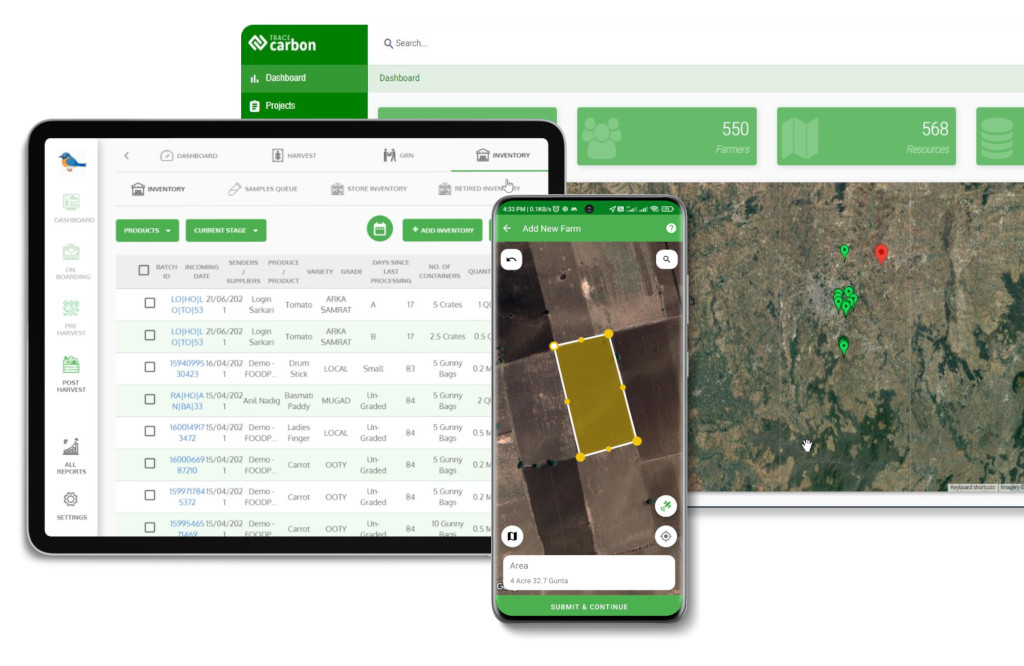Contact: +91 99725 24322 |
Menu
Menu
Quick summary: Learn what remote sensing means in environmental monitoring and how satellite technology supports climate action, compliance (EUDR, CSRD), and sustainable agriculture.

Remote sensing refers to the acquisition of information about Earth’s surface using satellite or aerial sensor technologies. This data supports climate monitoring, land use mapping, deforestation alerts, and precision agriculture.
As climate volatility intensifies, industries from agriculture to forestry are under pressure to monitor land use, carbon impact, and ecosystem health—without boots on the ground. That’s where remote sensing steps in. Using satellite and aerial imagery, remote sensing provides real-time, scalable insights into soil health, crop performance, deforestation, and water stress. It eliminates manual gaps in monitoring and equips organizations with verifiable data to meet sustainability goals and regulatory demands.
According to UN Global Working Group, Satellite imagery has significant potential to provide more timely statistical outputs, to reduce the frequency of surveys, to reduce respondent burden and other costs and to provide data at a more disaggregated level for informed decision making.
From tracking changes in land use and vegetation to monitoring air and water quality, this blog explores how these cutting-edge technologies redefine our approach to environmental conservation. Join us on a journey into the realm of Remote Sensing and Satellite Technology, where innovation meets environmental stewardship.
Key Takeaways
Remote sensing is the science and technology of collecting data about the Earth’s surface from a distance, typically using satellites, drones, or aircraft equipped with sensors. These sensors capture images and measurements across various wavelengths (e.g., visible, infrared, microwave), enabling environmental analysts, policymakers, and agribusinesses to observe, monitor, and respond to ecosystem changes in real time.
Unlike traditional field-based monitoring, remote sensing offers a non-intrusive method to assess environmental health. It minimizes human intervention while delivering macro-to-micro scale insights, making it ideal for vast or inaccessible areas like rainforests, deserts, or mountainous regions.
In the face of accelerating climate change, satellite data helps track critical indicators such as:
This information equips governments and businesses to take preemptive action based on data rather than forecasts or guesswork.
Remote sensing supports compliance with international sustainability regulations like:
By using Earth observation data, companies can validate and automate sustainability claims for audit-ready reporting.
Pairing remote sensing with AI and IoT enables:
For farmers and agri-enterprises, remote sensing delivers:
Remote sensing is not just a tool—it’s a strategic enabler for sustainability, traceability, and risk mitigation. As satellite resolution improves and AI accelerates analysis, expect remote sensing to become a cornerstone of environmental governance and climate-smart operations across industries.
Unlock the power of
NDVI for Sustainable Agriculture to drive smarter, more sustainable farming decisions.
Satellite technology plays a foundational role in modern environmental monitoring by offering consistent, scalable, and real-time observations of Earth’s ecosystems. Platforms like Sentinel-2 (from the EU’s Copernicus program) and Landsat (by NASA-USGS) deliver multispectral imagery that tracks changes in land cover, vegetation, water bodies, and atmospheric patterns over time—at both regional and global scales.
Satellite data allows for uninterrupted monitoring of sensitive areas like the Amazon, the Arctic, or mangrove forests—regions where manual inspection is often impossible. This objectivity reduces the risk of data manipulation and increases accountability in land-use decisions.
Satellites offer scientifically validated inputs for:
This supports corporate ESG disclosures, CSRD alignment, and Net Zero strategies with hard evidence rather than assumptions.
Using NDVI (Normalized Difference Vegetation Index) and thermal imaging, satellites like Sentinel-2 help:
This empowers climate-smart agriculture and supports farmers with timely, data-driven advisories.
Cloud-based satellite platforms (like Google Earth Engine or Copernicus Open Access Hub) allow researchers, startups, NGOs, and even individual farmers to access environmental data—breaking down the traditional barriers of cost, infrastructure, and expertise.
During floods, droughts, wildfires, or pest outbreaks, satellite feeds enable:
Satellite technology is the digital backbone of planetary stewardship—scaling environmental intelligence from pixels to policy. As spatial resolution improves and machine learning enhances analytics, satellites will not just monitor the planet but actively guide how we restore, protect, and sustain it.
Remote sensing is transforming how we manage agricultural ecosystems and sustainability commitments, bringing data-driven intelligence to landscapes that were once managed by intuition alone. From crop fields to forest reserves, satellites and aerial sensors now offer precise, real-time insights that can boost yields, reduce environmental impact, and support global compliance frameworks like EUDR, CSRD, and carbon markets.
What it does:
Crop monitoring with NDVI isn’t just about yield; it’s about preventive agriculture. With geospatial data, agri-businesses can move from reactive problem-solving to proactive field management—ensuring both food security and economic stability. It also empowers insurance companies and lenders to better assess field-level risk for crop loans.

What it does:
In the context of supply chain traceability, real-time deforestation alerts provide geo-verification of sourcing areas. For brands and importers, this creates proof of origin and reduces liability under EU laws. Combined with farm plot mapping, it’s a crucial due diligence asset.
What it does:
With water scarcity worsening, satellite-driven irrigation management is now a climate resilience imperative. Integrating soil moisture indices with weather forecasts can create dynamic irrigation calendars—especially impactful in drought-prone regions like parts of India and Africa.
What it does:
Remote sensing helps validate carbon sequestration claims—essential for participation in voluntary carbon markets and ESG disclosures. As satellite resolutions improve, it becomes possible to validate carbon credits at the farm or plot level, bridging the gap between smallholder farmers and climate finance.
These remote sensing applications are not standalone—they form a data layer that enhances traceability, sustainability reporting, and compliance workflows. When integrated into digital platforms like TraceX, they bring ground truth to global policies, making sustainability both measurable and actionable.

Remote sensing is no longer just a tool for scientific observation—it’s now a core enabler of global regulatory compliance, helping companies prove what’s happening on the ground, remotely and in near real-time. Here’s how satellite-based monitoring empowers businesses to meet key international regulations:
The EUDR System (Regulation EU 2023/1115) mandates geo-coordinates and land-use verification for products like cocoa, coffee, palm oil, and timber.
Remote sensing supports this by:
Under the EU’s CSRD, large companies must report ESG (Environmental, Social, Governance) data, including climate risks and biodiversity impact. Remote sensing enables:
By integrating satellite-derived data into ESG dashboards, businesses move beyond narrative claims to evidence-backed sustainability disclosures.
Remote sensing directly supports:
It also indirectly supports other SDGs like:
Remote sensing is one of the few scalable technologies that can track planetary health in a way that aligns both public policy and private-sector accountability.
TraceX leverages satellite technology as a foundational layer for building transparent, sustainable, and regulation-ready supply chains—especially in agriculture and forestry-linked sectors. Here’s how:
TraceX uses satellite imagery to geo-tag farm plots with precise boundary mapping (via polygon or point coordinates). It overlays NDVI (Normalized Difference Vegetation Index) and multispectral data to monitor:
This ensures traceability from farm to fork while enabling real-time insights for agronomists and sustainability managers.

Integrated with public datasets like GRC and Hansen Data Sets TraceX can detect forest cover changes over time. This helps businesses:
It provides the geospatial evidence required for EU TRACES filings, due diligence statements, and risk assessments.
Satellite-backed geolocation enables:
This streamlines KYC and land legality documentation, a core part of compliance under regulations like EUDR, Fairtrade, and Rainforest Alliance.

TraceX visualizes satellite-derived insights in dashboards that track:
These dashboards support Scope 3 emissions tracking, ESG reporting, and climate-smart strategy implementation for corporates, FPOs, and exporters.
Remote sensing is transforming how we monitor environmental health, agricultural practices, and regulatory compliance. From detecting illegal deforestation to optimizing irrigation in farmlands, satellite and aerial imagery offer an unmatched ability to collect real-time, scalable, and non-invasive data. As climate risks and sustainability requirements intensify, remote sensing has evolved into a critical technology for governments, agribusinesses, and sustainability leaders alike. Platforms that integrate these capabilities—like TraceX—enable proactive, compliant, and data-driven decisions at every level of the value chain.
From detecting forest loss in real time to improving yields with precision insights—get the full picture.
Explore how
Smart crop management technologies are transforming sustainable agriculture and compliance
Remote sensing involves collecting environmental data from satellites or aerial sensors to monitor land use, deforestation, crop health, and more without ground contact.
It verifies land-use history, deforestation status, and geolocation of farms—key requirements under regulations like the EU Deforestation Regulation (EUDR) and CSRD.
Agriculture, forestry, conservation, carbon markets, and ESG reporting benefit the most by integrating satellite insights into traceability and compliance workflows.
